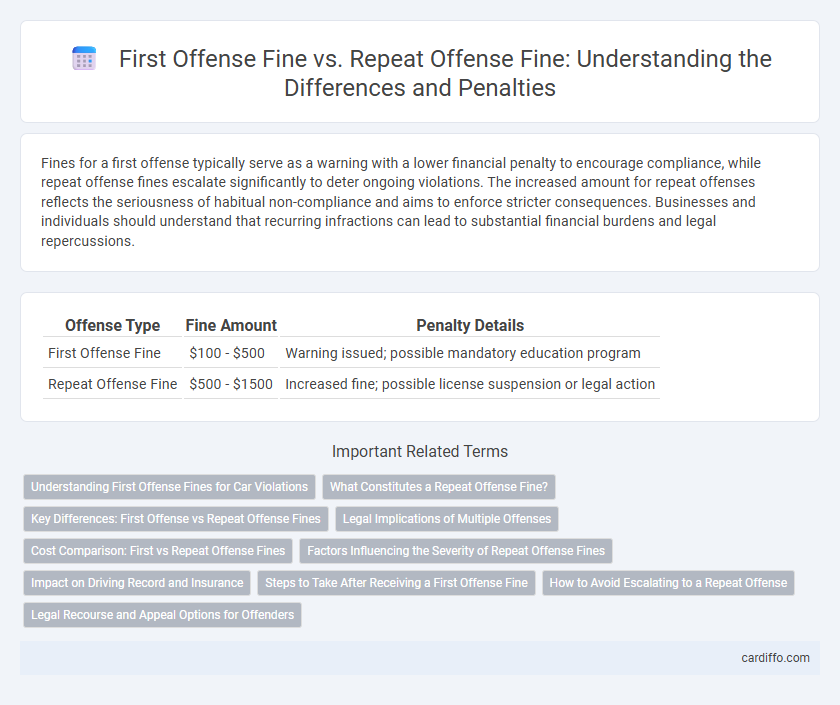Fines for a first offense typically serve as a warning with a lower financial penalty to encourage compliance, while repeat offense fines escalate significantly to deter ongoing violations. The increased amount for repeat offenses reflects the seriousness of habitual non-compliance and aims to enforce stricter consequences. Businesses and individuals should understand that recurring infractions can lead to substantial financial burdens and legal repercussions.
Table of Comparison
| Offense Type | Fine Amount | Penalty Details |
|---|---|---|
| First Offense Fine | $100 - $500 | Warning issued; possible mandatory education program |
| Repeat Offense Fine | $500 - $1500 | Increased fine; possible license suspension or legal action |
Understanding First Offense Fines for Car Violations
First offense fines for car violations typically involve lower penalties compared to repeat offense fines, reflecting a one-time infraction without prior history. These fines serve as a warning and financial deterrent, encouraging drivers to adhere to traffic laws before facing steeper consequences. Understanding the specific fine amounts and legal procedures for first offenses is crucial for drivers to avoid escalating penalties and potential license suspensions.
What Constitutes a Repeat Offense Fine?
A repeat offense fine is imposed when an individual commits the same violation within a specified time frame, often defined by local laws or regulatory agencies. This fine is typically higher than the first offense fine to deter recurring non-compliance and reinforce legal consequences. Understanding the exact duration and criteria for a repeat offense is essential for accurate legal interpretation and financial planning.
Key Differences: First Offense vs Repeat Offense Fines
First offense fines typically carry lower penalties to encourage compliance and awareness, while repeat offense fines are substantially higher to deter habitual violations and emphasize accountability. The escalation in fines for repeat offenses reflects stricter enforcement policies aimed at reducing recidivism and promoting public safety. Legal frameworks often include graduated fine schedules, with repeat fines sometimes doubled or tripled compared to initial penalties.
Legal Implications of Multiple Offenses
First offense fines typically serve as a deterrent with moderate penalties, whereas repeat offense fines escalate significantly to emphasize accountability and prevent habitual violations. Legal implications of multiple offenses often include increased fines, potential license suspension, and mandatory court appearances, reflecting the severity of repeated non-compliance. Courts may also impose stricter sanctions or rehabilitation programs to address the underlying behavior associated with recurrent offenses.
Cost Comparison: First vs Repeat Offense Fines
First offense fines typically range from $100 to $500, serving as a deterrent without severe financial burden. Repeat offense fines increase significantly, often doubling or tripling to $1,000 or more, reflecting stricter penalties to discourage recurring violations. The cost comparison emphasizes the escalating financial consequences faced by repeat offenders, underlining the importance of compliance to avoid higher fines.
Factors Influencing the Severity of Repeat Offense Fines
First offense fines typically serve as warnings with lower penalties, while repeat offense fines escalate based on factors such as the number of prior violations, the nature of the offense, and the offender's compliance history. Jurisdictions often apply multiplier effects or increased minimum penalties to deter habitual offenders, reflecting the increased risk or harm associated with repeated non-compliance. Severity also depends on aggravating circumstances, including the offense's impact on public safety and previous enforcement actions.
Impact on Driving Record and Insurance
First offense fines typically result in fewer demerit points added to the driving record, causing minimal impact on insurance premiums. Repeat offense fines often lead to higher demerit points, increasing the risk of license suspension and significantly raising insurance rates. Insurance companies consider repeat violations high risk, leading to costly policy adjustments and potential coverage denial.
Steps to Take After Receiving a First Offense Fine
After receiving a first offense fine, immediately review the citation details and payment deadlines to avoid additional penalties. Contact the issuing authority to inquire about possible fines reduction programs or first-time offender leniency options. Keep records of all communications and payments to support your case if repeat offenses occur or disputes arise.
How to Avoid Escalating to a Repeat Offense
Understanding the differences between first offense fines and repeat offense fines is crucial for effective compliance. First offense fines are typically less severe and serve as a warning, while repeat offense fines carry higher penalties due to continued non-compliance. To avoid escalating to a repeat offense fine, individuals should prioritize adherence to regulations, maintain thorough records, and promptly address any violations upon initial notification.
Legal Recourse and Appeal Options for Offenders
First offense fines often allow offenders more straightforward legal recourse, including options for plea bargains and reduced penalties through timely appeals. Repeat offense fines typically carry harsher penalties with limited appeal opportunities, reflecting the judicial system's intent to deter recidivism. Offenders facing repeat fines should consult legal counsel to navigate complex appeal processes and explore possible mitigation based on case specifics.
First Offense Fine vs Repeat Offense Fine Infographic

 cardiffo.com
cardiffo.com